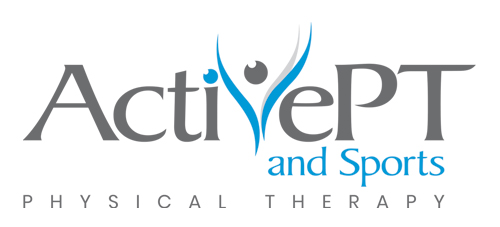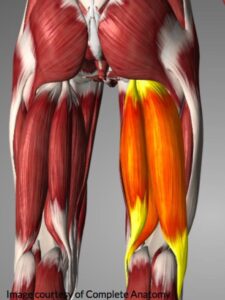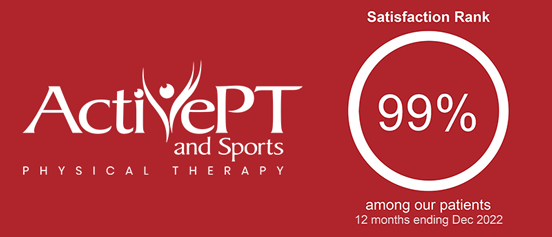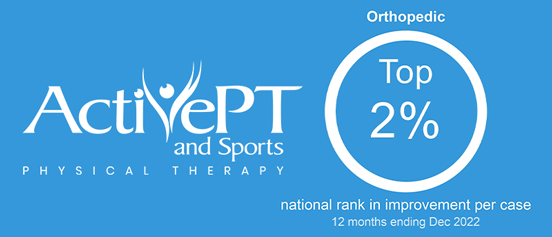by Savannah Meaike, DPT, RRCA, and Kayla Kramer, DPT, and Jill Tacl, DPT, OCS, RRCA, and Garrison Jones, DPT, CSCS, RRCA, and Megan Bernard, PTA, RRCA
If you’re a runner, you’ve likely been injured at some point during your training, and you’re not alone. A recent study followed 300 runners over 2 years. They found that 73% of women and 62% of men sustained an overuse running injury during this time period. In our four-part series of common running injuries, we covered common running-related injuries at the ankle and the knee. In this blog, we are going to cover running-related injuries occurring at the hip joint. Three common injuries that we often see in the clinic include Hamstring strains, piriformis syndrome, and labral pathology, often mistaken for a hip flexor strain.
Hamstring Strains
With races being canceled or postponed over the past few months, runners are anxious to get back to competing. Most half-marathon and marathon training programs incorporate interval training and speed work into their weekly regime. Hamstring injuries are one of the most common injuries that occur during speed work and, unfortunately, they have a high recurrence rate.
First, let’s learn a little about the hamstring muscles. Not just one muscle, the hamstring is actually a group of three muscles that run along the back of your thigh: the semimembranosus, semitendinosus, and biceps femoris. Their combined action is usually thought to bend the knee, but in runners, the hamstrings serve a very important action. During the terminal swing phase of gait, the foot is kicked out in front and the knee changes from a bent position to fully straight, right before the foot hits the ground. The biceps femoris muscle is commonly injured in runners and the injury typically occurs during the terminal swing phase of the running gait cycle because the muscle must contract while it is lengthening to slow down the straightening of the knee. This eccentric activity (contracting while stretching) is the reason the hamstring is most susceptible to strain and injury during high-speed running (speed work and interval training).
Risk Factors
There are several risk factors that may contribute to a hamstring injury in a runner: inadequate or lack of a warm-up (research has proven a dynamic warm-up to be most effective), muscle imbalance (overdevelopment of the quadriceps and weak gluteal muscles leading to overuse of hamstring muscles), excessive fatigue (lack of adequate rest days), and decreased flexibility. See our blog post on dynamic warm-ups for runners.
Common Symptoms
Sudden or sharp pain in the back of the thigh, “popping sensation” at time of injury, swelling and/or bruising within the first 24 hours, weakness, and inability to walk or jog pain-free.
Physical Therapy Treatment
Common treatment for a hamstring injury would include a thorough assessment of your injury with recommendations for pain relieving treatments, soft tissue massage, dry needling, taping, icing, compression, gentle stretching, and eccentric strengthening exercises. Treatment from a running-specific physical therapist should also include an appropriate treatment timeline based on your goals and performance level, running-related drills once tolerated, and a training program to help you return to running safely.
Piriformis Syndrome
The piriformis muscle is a small, stabilizing muscle located deep within the hip joint under your gluteal muscles. Its primary function is to externally rotate the hip and stabilize your pelvis. Repetitive activities such as running can cause the piriformis to become irritated or inflamed and this can lead to irritation of the sciatic nerve, which can then cause symptoms down into the thigh. For these reasons, piriformis syndrome is often confused with “sciatica” or “hamstring strain”. Often, weakness in the gluteal muscles plays a large role in the development of piriformis syndrome.
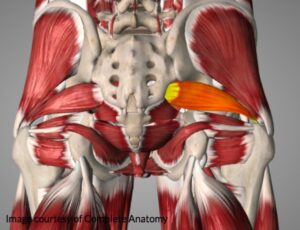
Common Symptoms
Runners typically present with the following symptoms: pain with sitting, squatting, and climbing stairs. You may experience tenderness along the gluteal muscles deep where the piriformis muscle runs. Pain may or may not refer down the back of your thigh and calf.
Physical Therapy Treatment
Treatment for piriformis syndrome starts with education on symptom management, load tolerance, and training modifications. At Active PT, we take a hands-on approach to treating piriformis syndrome, including deep tissue massage, trigger point release, dry needling, and stretching. Treatment includes strengthening the gluteals, as it is a high priority for long-term recovery from piriformis syndrome, but strengthening takes time. Addressing the soft-tissue restrictions and pain producers with hands-on care can help get runners back on their training schedule more quickly when dealing with piriformis syndrome.
Labral pathology Vs. Hip flexor strain
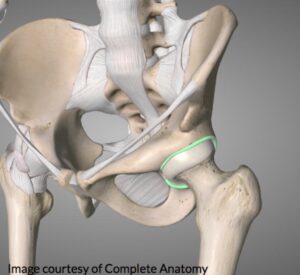
The two most common causes of pain in the front of your hip (groin line) that we see in runners are labral irritation/tear and hip flexor strain. If we take a closer look at our hip’s anatomy we can see why these may be commonly confused. Highlighted in green in the image is our Labrum, a layer of cartilage that improves the stability of our hip joint as we move.
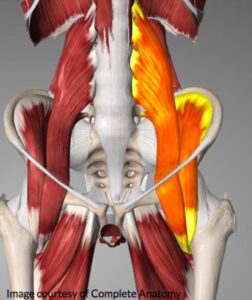 Highlighted in yellow are the hip flexor muscles, the Psoas, and Iliacus. They connect from our lower back and upper pelvis to the front of our upper thigh. If you are lifting your knee, you are using your hip flexors.
Highlighted in yellow are the hip flexor muscles, the Psoas, and Iliacus. They connect from our lower back and upper pelvis to the front of our upper thigh. If you are lifting your knee, you are using your hip flexors.
Risk Factors
The most common risk factor for a labral tear in runners is FAI (femoroacetabular impingement). This means that you have extra bone along the ball and/or socket of your hip joint. FAI in itself is not a problem, and everyone’s anatomy will always
be a little different. It only becomes a problem when the pinching results in a labral tear, thus producing pain.
Runners who overextend their hip during the push-off phase of running may be at risk of irritating an already sensitive hip. The reason for this is that during hip extension the femoral head slides forwards slightly in its socket, placing an increased load through the top rim of the labrum.
Typically a muscle strain to the hip flexor while running occurs when the hip slips backward. This may be while you are running on a slick surface and your foot is slipping backward. This may be one big slip or several repetitive small slips throughout your run.
Other risk factors for both labral or hip flexor injury could be increased mileage, increased hill work or lack of an adequate warm-up.
Common symptoms
The location of symptoms in a labral tear and a hip flexor strain can be very similar, so let’s look at a few symptoms that may help us differentiate the two. With a symptomatic labral tear you may experience clicking, locking, or symptoms of instability in your hip. There may also often be decreased range of motion in your injured hip compared to your non-injured hip. You may experience more of a deep dull ache while resting, however typically sharp pain is also experienced during certain movements. While both can produce pain in the front of the hip or groin, pain from a labral tear can occur on the outside of your hip or deep in your buttock, which can also help to differentiate a labral tear from a hip flexor strain.
In a hip flexor strain, you will typically experience sharp pain with contraction (lifting your hip) or stretching of your hip flexor muscle (extending your hip), the severity of this pain may depend on the grade of your tear. You may also experience hip flexor weakness along with the pain. A running-specific physical therapist can perform special tests to quickly assess which issue you are having.
Physical Therapy Treatment
If you have a labral tear, non-surgical treatment is preferred. Treatment usually starts with in-clinic physical therapy to improve your hip’s range of motion and reduce symptoms. We also focus on glute strengthening to offload the passive structures in your hip joint including the cartilage that makes up your labrum. Decreasing your stride length, or increasing your cadence, prevents the excessive hip extension that was mentioned as a risk factor and thus offloads the labrum and hip joint as well. This increased cadence can result in better use of your muscles in shock absorption during the impact of running. Lastly improving balance, control, and flexibility of muscles depending on your specific impairments may help to return your hip to a non-painful state.
If you have a hip flexor strain, physical therapy may include offloading and incorporating more cross-training depending on the severity of the strain. Gradually strengthening your hip flexor in a methodical fashion will allow proper healing of the injured muscle. Your physical therapist will also educate you on an adequate warm-up specific to the injured hip flexor muscle, as this has been shown to decrease the risk of injury.
Some of the leading research scientists in hip impingement have shown that insufficient strength or coordination of the hip flexors during hip flexion or gluteus maximus during hip extension can lead to an increase in the anterior glide of the femoral head. Thus, for both diagnoses, we can help to offload the symptomatic tissue by completing exercises specific to these muscles.
Lastly, for both diagnoses, we will use various manual therapy techniques to help alleviate your symptoms so that you may continue with running and other activities with fewer symptoms. We will also help to guide you through a graded return to your mileage goal, with education on training parameters.
If you have tried self-treatment and pain is not reducing, consider recommendations specifically for you. Physical therapists can offer an extensive amount of information to help you get back to running without pain. Schedule a free 15-minute screening appointment to meet with one of our running specialists one on one and get your running injury questions answered today. If you are looking to take your running to the next level, check out our running performance packages.
RUNNING SPECIALISTS AT ACTIVE PT
